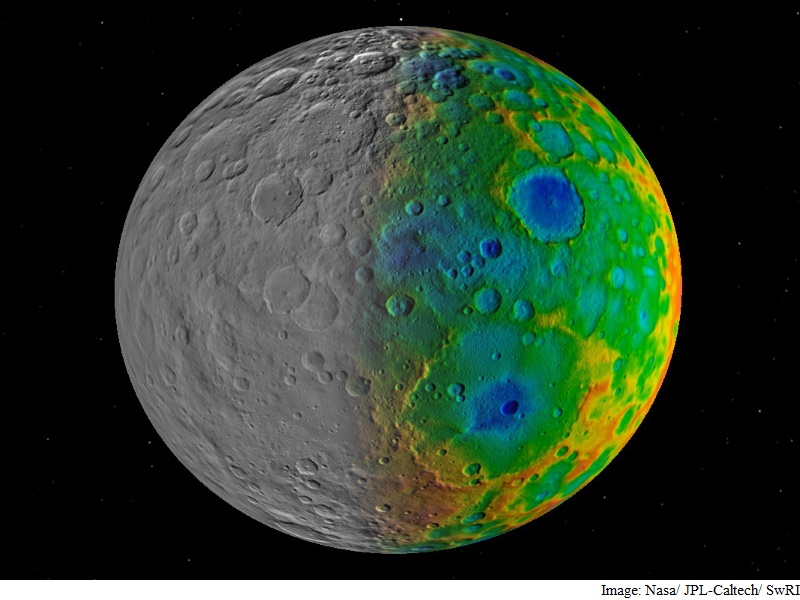In an intriguing find, scientists associated with Nasa's Dawn spacecraft
have discovered a mysterious disappearance of a significant number of
large craters on dwarf planet Ceres, indicating something has happened
to it.
Nasa's Dawn spacecraft arrived to orbit Ceres in March 2015 and
mission scientists expected to find a heavily-cratered body generally
resembling the protoplanet Vesta - Dawn's previous port of call.
Instead,
as the spacecraft drew near to Ceres, a somewhat different picture
began to emerge: Something has happened to Ceres to remove its biggest
impact basins.
Now, a team of Dawn scientists led by Simone Marchi
from the Southwest Research Institute in Boulder, Colorado suggest that
Ceres has experienced significant geological evolution, possibly
erasing the large basins.
"We concluded that a significant
population of large craters on Ceres has been obliterated beyond
recognition over geological time scales, which is likely the result of
Ceres' peculiar composition and internal evolution," Marchi explained in
a paper published in the journal Nature Communications.
According
to David Williams from Arizona State University, "When we first
starting looking at Ceres images, we noticed that there weren't any
really large impact basins on the surface."
None are larger than 285 km across.
This
presents a mystery, he says, because Ceres must have been struck by
large asteroids many times over its 4.5-billion-year history.
"Even
Vesta, only about half of Ceres' size, has two big basins at its south
pole. But at Ceres, all we saw was the Kerwan Basin, just 285 km in
diameter," Williams added. "That was a big red flag that something had
happened to Ceres."
The team's simulations of collisions with
Ceres predicted that it should have 10 to 15 craters larger than 400 km
in diameter, and at least 40 craters larger than 100 km wide.
In reality, however, Dawn found that Ceres has only 16 craters larger than 100 km, and none larger than the 285-km Kerwan Basin.
So what removed Ceres' large craters and basins?
"If
Ceres were highly rocky, we'd expect impact craters of all sizes to be
preserved. Remote sensing from Earth, however, told us even before Dawn
arrived that the crust of Ceres holds a significant fraction of ice in
some form," Williams explained.
If Ceres' crust contained a large
proportion of ice - especially if mixed with salts - that would weaken
the crust and let the topography of a large basin relax and become
smoother, perhaps even disappear.
In addition, said Williams, Ceres must have generated some internal heat from the decay of radioactive elements after it formed.
This too could also have helped soften or erase large-scale topographic features.
Nasa plans for Dawn to continue orbiting Ceres as the dwarf planet makes its closest approach to the Sun in April 2018.
Scientists want to see if the increasing solar warmth triggers any activity or produces detectable changes in Ceres' surface.
 AI Study Finds Organic Molecules on Ceres Likely Came from Asteroid Impacts3 February 2025
AI Study Finds Organic Molecules on Ceres Likely Came from Asteroid Impacts3 February 2025 Dwarf Planet Ceres Once Hosted a Muddy Ocean Below Its Icy Surface8 October 2024
Dwarf Planet Ceres Once Hosted a Muddy Ocean Below Its Icy Surface8 October 2024 Ceres Dwarf Planet Is an ‘Ocean World’ With Salty Water Underground, NASA Data Suggest11 August 2020
Ceres Dwarf Planet Is an ‘Ocean World’ With Salty Water Underground, NASA Data Suggest11 August 2020 NASA's Dawn Spacecraft Hit by Glitch on Extended Mission27 April 2017
NASA's Dawn Spacecraft Hit by Glitch on Extended Mission27 April 2017 NASA Spacecraft Detects Organic Compounds on Dwarf Planet Ceres, Raising Prospect of Life17 February 2017
NASA Spacecraft Detects Organic Compounds on Dwarf Planet Ceres, Raising Prospect of Life17 February 2017



![Gadgets 360 With Technical Guruji: News of the Week [April 12, 2024]](https://c.ndtvimg.com/2025-04/jlpk5kco_news-of-the-week_160x120_12_April_25.jpg?downsize=180:*)











